Cats and dogs account for approximately 184 million of the total number of pets owned by households in the United States. According to the American Pet Products Association, pet food and treats sales were worth US$ 42.0 billion in 2020 and US$ 44.1 billion in 2021 within the US market. Animal materials considered inedible for human consumption are processed for use as pet food and treats. Type of animal by-products that are rendered include offal, fat, blood, bones, meat trimmings and viscera. The fastest growing categories in the pet food industry are raw, frozen, and freeze-dried products. Raw pet food sales grew 196% and frozen pet food grew 235% between 2012 and 2016. It is assumed that raw, frozen and freeze-dried products have a long shelf-life. The main ingredient in pet food is meat, with considerable amounts of water and large concentrations of fat and protein. However, extended storage and freezing time, multiple freeze-thaw cycles during transport and storage of raw-frozen foods and high temperature applied to rendered protein meals can impact meat quality, damage proteins and amino acids, make proteins less digestible, and increase the level of oxidation products. Therefore, it is essential to evaluate the quality of the fat and protein contents of pet food to ensure a nutritionally complete diet.
Lipid oxidation in pet food
Rendered animal protein meals, which are used in extruded pet food products, provide higher quality protein than raw meat. Fat is separated from the cooked material during the rendering process; however, some remaining fat can oxidise and become rancid after storage for a long period of time if it is not protected. Therefore, it is essential to understand which antioxidants are effective to control oxidation. Oxidised pet food impacts the animals consuming the diet. For example, puppies fed an oxidised diet have lower weight gain, decreased serum vitamin E, lower linoleic acid, and slower bone formation. Furthermore, raw-frozen pet food may experience multiple freeze-thaw cycles as it is being transported, purchased, and stored, leading to the potential for product oxidation. In addition to the number of freeze-thaw cycles and the length of storage time, the type of antioxidant used will affect the degree of oxidation that occurs within a product.
Protein oxidation in pet food
Fresh meats and meat meals are two raw materials used as protein sources in dry pet food. Fresh meats are obtained from the meat rejected as unfit for human consumption with no signs of disease transmissible to humans, while meat meals are derived from animal parts such as hooves, horns, bristles, and feathers that are not consumed by humans. Meat meals undergo an intensive industrial process using high temperatures, 115 to 145°C (240 to 290 °F) as a method to separate and melt the fat from the solids. High temperature may damage proteins and amino acids, making them less digestible, cause protein oxidation, partial degradation of raw materials and alteration in organoleptic and nutritional properties of pet food products. In addition, inappropriate storage condition increases the proliferation of microorganisms, degrades organic components, and develops harmful products, such as biogenic amines.

Improving shelf-life and product stability
Pet food processors and manufacturers need to prevent microbial growth, control pH and use traditional or natural additives to prevent oxidation to improve pet food shelf-life and stability.
Managing microbials
Effective microbial shelf-life preservation is a critical factor in the long-term market success of pet food. The risk of microbial (yeast, mould, bacteria) growth is lower in dry products versus semi-moist products. Moreover, pH reduction is required to inhibit microbial growth. Acid ingredients or acid salts can be used as feed additives to reach the target pH. However, major issues with using additives include identifying the most appropriate additive for the specific product, determining the proper dosage and finding the best location to add them to ensure good distribution. Antimicrobial agents include acids such as acetic acid, benzoic acid and citric acid, as well as non-acids such as nitrites and sulphites. Factors to account for when choosing the best antimicrobial agent for pet food products comprise acidity index, the presence of other inhibitors such as salt, smoke, sugar, moisture content, solubility, length of storage and temperature conditions.
Controlling oxidation
Delaying the onset and rate of lipid oxidation by adding antioxidants is an effective, convenient and economical strategy that can be used to improve product stability and shelf-life. Lipid oxidation can cause nutritional deterioration and produce undesirable flavours, colour and toxic compounds that often make food less acceptable to pets. Antioxidants work by scavenging free lipid radicals, controlling transition metals, quenching singlet oxygen and inactivating sensitisers. Hydrogen atoms are donated by antioxidants to free radicals and as a result, convert them to more stable, nonradical products. Antioxidant activity depends on a variety of factors, such as temperature, pH, degree and amount of unsaturated fatty acids, and the presence of oxygen and metal ions.
Concluding remarks
The goal of veterinarians, nutritionists, pet food manufacturers, and pet owners is long and healthy lives for dogs and cats, using healthy pet food. Extended storage and freezing time, multiple freeze-thaw cycles occurring during transport and storage of raw-frozen foods, and application of high temperatures during food processing may impact pet food quality, increase the level of oxidation products, damage proteins and amino acids and make them less digestible. Safe and healthy pet food comes from safe ingredients sourced from well-monitored suppliers; therefore, a better understanding of the ingredients and application of methods that can be used to improve pet food shelf-life and stability is an important part of pet food production.
"ingredients" - Google News
June 01, 2022 at 02:08PM
https://ift.tt/dq4XInR
Shelf-life evaluation of ingredients in pet food - All About Feed
"ingredients" - Google News
https://ift.tt/YkmhlUK
Shoes Man Tutorial
Pos News Update
Meme Update
Korean Entertainment News
Japan News Update
Bagikan Berita Ini














0 Response to "Shelf-life evaluation of ingredients in pet food - All About Feed"
Post a Comment